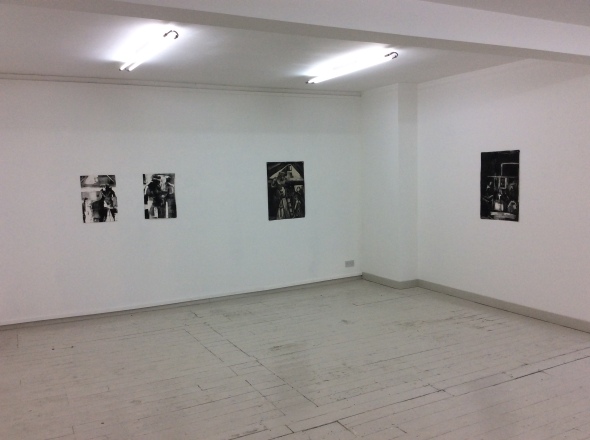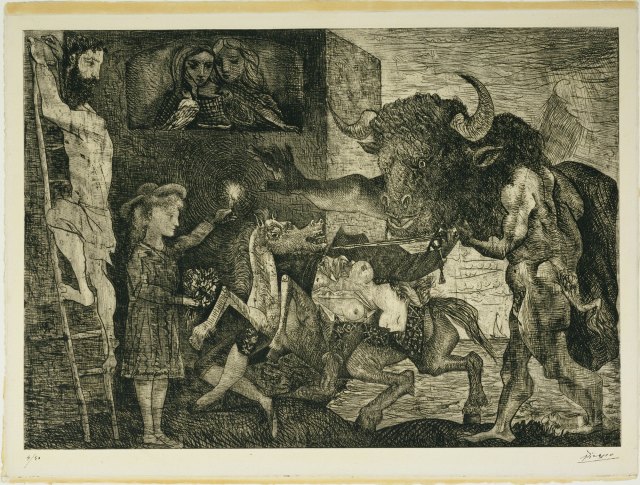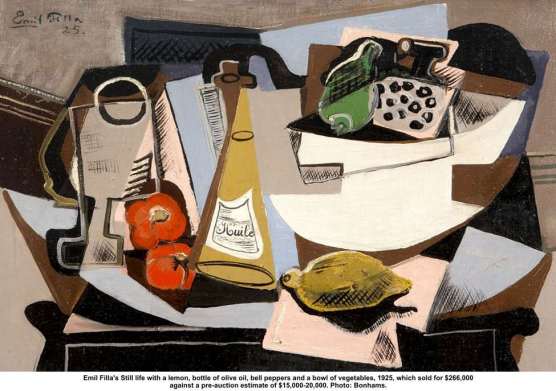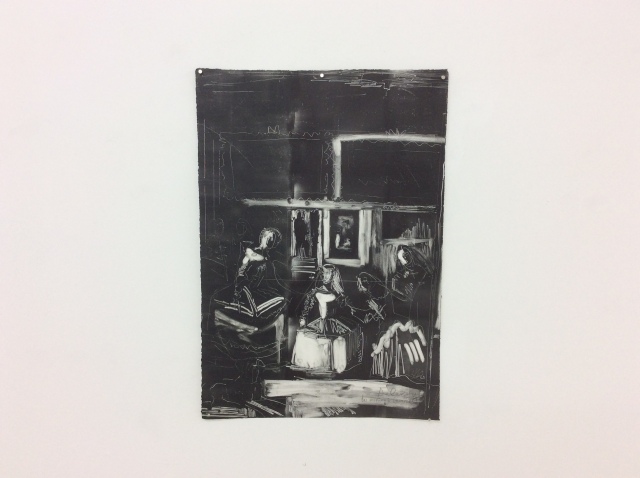The cubist painter Andre Lhote (1885 -1962) jealously chastised Emil Filla (1882 – 1953) for being “plus Picassian que Picasso lui même” – a memory of which surfaced when I saw one particularly superb monotype at the current exhibition upstairs at Fenderesky Gallery:

From the left: Thinking of Camille at Doonsaskin Minotaur, 54x38cm; Minotaur Torso, 54x38cm; Walk like an Egyptian, 78x56cm; Las Meninas(reversed),77x53cm, all oil on paper monotypes, 2017
Not only the shared motif, but Delargy’s visual thought and its power evoked Picasso for me. Not his analytic cubist style either. Rather the primordial Dionysian principle and the idea of perspectivity as revived by Friedrich Nietzsche (1844 -1900). I am not suggesting that either of the above painters read Nietzsche, however during 1930s the varied receptions and interpretations of his philosophy provoked wider dissemination, for example of both Thus spoke Zarathustra and The Birth of Tragedy. In 1937, Georges Bataille was led to argue against any “instrumentalization” of Nietzsche’s thought… perhaps reflecting the respect instead of the tendentious variety of other judgments. (In Sur Nietzsche, 1937, transl as On Nietzsche, 2004)

Pablo Picasso, Minotauromachy 1935, etching, accessed on https://www.moma.org/collection/works/60110
Nietzsche’ s declaring sublime art as the only ” metaphysical consolation of being” became a strong tendency and not just in so called Poststructuralism. (as in A D Schrift(1995), Nietszche’s French Legacy)
The head of the minotaur in Picasso’s etching shares with the monotype by Delargy that idea of the sublime, also the focus on detail appears to connect the two painters, namely the detail of the eye.
Delargy dissipates accuracy of dramatic description thus allowing presence of both the fantasy-invention of a man/animal and of its clay model in the studio ( mentioned to me by Dr Jamshid Mirfenderesky) to meet in believable simultaneous time and space. The “thingness” of the interior troubles the living head by putting obstacles between the Minotaur and the viewer. Yet, the eyes watched me, I sensed the animals living force. Delargy treats the drama as poetry – not as a story. The power of the animal’s sight not only absorbed my “existence” but erased the rest with honest and primordial intensity of immediate impact. Perhaps, comparison with the Dionysian intoxication may appear appropriate. I felt the eye alive and looking at me. Black and white, so ordinary ingredients of these monotypes produce elixir of life from a brushmarks, on the condition that the artist flirts with alchemy.
In 1956/7 Pablo Picasso painted 58 scenes of and from Las Meninas (1656) by Diego Velazquez. He gave the complete suite to the Museum Picasso in Barcelona.
Delargy possibly thinks of a series too – indicated by the bracketed word (reversed) as if to distinguish it from another variant.
Picasso chose horizontal format and focus on the central group. Delargy also ignores other figures while he reverts to the vertical composition of Velazquez .

By Diego Velázquez – Galería online, Museo del Prado., Public Domain, https://commons.wikimedia.org/w/index.php?curid=15474596
The black and white monotype lost the innocence personalised by Marguerita – it is about the painterly issue of light. In the Picasso the light is given primary role too. Delargy uses light as Tintoretto does, to connect irrationally fragmented wholes into one whole pulsing organism/skeleton of. The sharp hard edged lights evoke thoughts of slashing the ground while they connect to make a net to catch that which is not fully visible.
Not all of the exhibits (altogether 15) installed share the power I see in the above examples. Some other offer a charming re-interpretation of Giorgione’s nude, with a secret nod to Manet’s Olympia – the awkward hand has been erased, but the pool of the tone remains as an undefined patch.
Thinking of Camille at Doonsaskin Minotaur I is a title still too cryptic without asking the painter. It looks like a view of the studio with a sculpture and a female figure.
Its Minotaur is nearer to the acting one in Picasso’s Minotauromachy – as is the female dressed in light – her gesture reminiscent of Picasso’s girl holding the candle light. It is also more painterly – the most generous offering by a monotype.
A small number of the monotypes has been allowed to go polychrome. Aesthetic experience of this exhibition revives sincere and freely chosen faithfulness to what Leonardo named the”mute poetry”.
Images of Delargy’s monotypes courtesy of Fenderesky Gallery.







